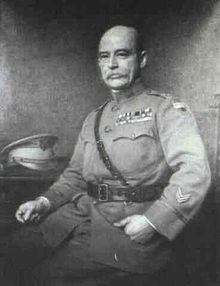Get Today in Masonic History into your Inbox. Sign up today for one of our email lists!
Need an article for your Trestleboard/Newsletter see our Use Policy
Harry Hill Bandholtz is Born

Today in Masonic History Harry Hill Bandholtz is born in 1864.
Harry Hill Bandholtz was an American soldier.
Bandholtz was born on December 18th, 1864 in Constantine, Michigan. He graduated from high school in 1881. He got a job as a billing clerk in Chicago. Later he found work as a bookkeeper. Around this time he joined the National Guard of the United States.
In 1890, Bandholtz graduated from the United States Military Academy at West Point. From 1890 to 1898, he was active in the United States Army and taught at the Michigan Agricultural College. In 1898 he was sent to Cuba at the start of the Spanish-American War.
In 1900, Bandholtz began serving a 13 year tour in the Philippines. Despite the feeling the Americans were yet another "tyrannical overseer", Bandholtz was well liked by the Filipino people. He was the only American Army officer elected to office by the people of the Philippines. In 1903, Bandholtz was appointed to the Philippines Constabulary and served in the Constabulary until his departure in 1913. He was also elected the commander of the Veteran Army of the Philippines.
In 1914, Bandholtz organized a joining of the United States Spanish War Veterans and the Veteran Army of the Philippines. This eventually led to the creation of the Veterans of Foreign Wars.
In 1917, Bandholtz was placed in command of the 58th Brigade of the 29th Division. He accompanied the unit to France to serve during World War I. Later the same year he was appointed United States Army Provost Marshal General to General John J. Pershing's American Expeditionary Force in France.
In 1919, Bandholtz was sent to Hungary as the US representative to the Inter-Allied Supreme Command's Military Mission. Once again he was well received by the local population. In part this was because of his mission to see occupying Romanian and Serbian troops left the country. He also was noted for two heroic acts on behalf of the Hungarian people. The first was he prevented the arrest of the Hungarian Prime Minister by Romanian troops. The second was his protection of the Hungarian National Museum. The story claims Bandholtz held off the Romanian troops from looting the National Museum with his riding crop and a sign which read "This door sealed by Order the Inter-Allied Military Commission. H.H. Bandholtz, President of the Day, October 5th, 1919." A statue was erected in Bandholtz honor in Hungary in 1936. After World War II when Communist rule came to Hungary the statue was removed. In the 1980's it was moved to the residence of the U.S. Ambassador. It was finally restored to it's place in 1989 prior to the visit of then President George Herbert Walker Bush.
In 1922, Bandholtz was sent to Mingo County, West Virginia where a rebellion among mineworkers broke out when two workers were assassinated on the steps of the courthouse. Eventually federal troops were deployed and order was restored.
Bandholtz passed away on May 11th, 1925.
Bandholtz lodge affiliation is not known, he was a member of Washington Chapter No. 3 of the Nation Sojourners, an organization for Masons who served in the United States military.
This article provided by Brother Eric C. Steele.

